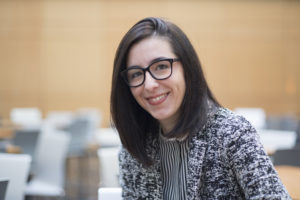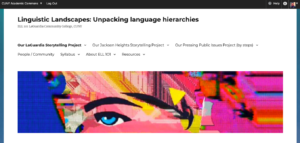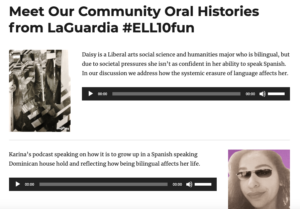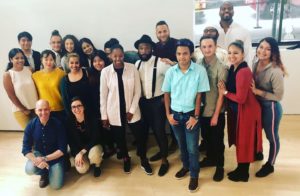Teaching on the Commons: Digital Storytelling & Linguistics with Inés Vañó García!

“Teaching keeps me learning from, and along with, my students. Each student’s experience is unique. I am able to challenge myself inside and outside the classroom, not being afraid to seek out creative and innovative approaches in order to question what naturally is taken for granted.”
– Inés Vañó García
Hello, members of the CUNYverse!
In our debut article of the Fall 2019 semester, In Common would like to lend the spotlight to fellow Commoner, Inés Vañó García! I interviewed Inés in order to learn more about her recent experience with having her linguistics students utilize audio recordings for her course taught on the CUNY Academic Commons. Inés is currently a Ph.D. candidate in Hispanic Linguistics (Latin American, Iberian, and Latino Cultures program) at The Graduate Center, as well as a Teaching Fellow at The Graduate Center’s Teaching and Learning Center. She was also recently a Mellon Graduate Teaching Fellow at LaGuardia Community College, where she taught ELL101: Introduction to Language (an introductory course to general linguistics) to undergraduate students where they used the CUNY Academic Commons as an interactive medium!

Inés has been a member of the CUNY Academic Commons for over 3 years now, and this past Spring semester she had the pleasure of working with Ryan Seslow (to be featured in an upcoming In Common article) to create a Commons site where her Introduction to Language course could be transformed into not only a superb collection, but also a prime example of digital storytelling! Upon building the site and scaffolding the course’s curriculum, the course site would come to be known as “Linguistic Landscapes: Unpacking Language Hierarchies!”

LaGuardia Community College, located in Queens, serves an incredibly diverse student body, serving well over 50,000 students from 100+ countries. With that taken into consideration, Inés wanted to build a course that lent a voice to a wide range of cultural, linguistic, and ethnic backgrounds present on LaGuardia’s campus. She was collaborating with her students to create an artistic collection of both visually appealing pieces, as well as podcasts (using Audacity, an open-source audio recording software) where the site’s visitors could learn about the linguistic identity of each member of their established community (listen to their podcasts and “meet” each member here)!
In terms of the previously mentioned visuals, the Linguistic Landscape’s group also learned how to create GIFs using the software Glitché (with a special thanks to tutorial videos by Ryan Seslow). While discussing and learning about the cultures and communities around them, these students focused on Jackson Heights in order to creatively express how they engage with the area by conducting their own forms of digital storytelling through moving images ranging from that of beauty to that of pure chaos (see examples here)!
 The Linguistic Landscape group ended up presenting their work as it was part of The Center for the Humanities’ Pressing Public Issues project! These students were able to share how our languages and language practices influence the way we interact with people and how language(s) relates to our role in society through their own lenses. At the end of the day, this group was able to better understand the power of relationships between individuals/groups/communities and they were able to identify identity what crafts our different communities’ identities.
The Linguistic Landscape group ended up presenting their work as it was part of The Center for the Humanities’ Pressing Public Issues project! These students were able to share how our languages and language practices influence the way we interact with people and how language(s) relates to our role in society through their own lenses. At the end of the day, this group was able to better understand the power of relationships between individuals/groups/communities and they were able to identify identity what crafts our different communities’ identities.
What is your pedagogical philosophy?
I asked Inés about her pedagogical philosophy, what was important when developing this experience, and she said she aims to follow a Socially Conscious Pedagogical approach, listing off the following ways in which she practices just that:
- “I am invested in making my students aware of my teaching practices and their methodological implications.”
- “I make my students active participants in the design of the course’s content by allowing them to select readings and by making sure that their expectations were met.”
- “Within my critical approaches, diverse students’ multilingual backgrounds become central to the language classroom, where monolingualism is not conceived as the norm.”
How did the CUNY Academic Commons help to make this possible?
According to Inés, utilizing the Commons as an Open Educational Resource (OER) has allowed students to put different texts, articles, and perspectives into conversation with one another without the limitations of a textbook. Our space allows for much more interaction between community members, rather than an alternative online classroom space that only consists of folders and files. The Commons’ compatibility with Hypothes.is allows for smooth annotating on the site’s pages for students and faculty to comment on one another’s work, sharing in one another’s experiences. Hypothes.is also allows the instructor to facilitate online discussions between students much more effectively.
Do you have any advice for instructors who want to teach on the Commons for the first time?
Don’t be afraid of not knowing how it works, take it slowly, don’t try to do too much at once. Take it one step at a time and experiment. It makes your life so much easier. Plugins like Reckoning allow for easy maintenance and evaluating student work. The Commons support team is excellent and will be very quick to help you, and it is worth it for the students.
Inés is the first of many amazing instructors around CUNY to be featured in this new focus of the In Common site, so if you’re teaching or doing research on the Commons, don’t hesitate to reach out!
Best,
Anthony



